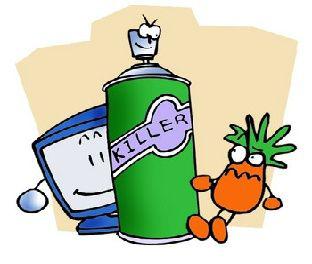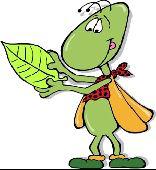Natural Solutions to Things That Bug You (3 page)
Read Natural Solutions to Things That Bug You Online
Authors: Myles Bader

Green Lacewings
Ladybugs
Mealybug Destroyer
Mites (beneficial)
Predatory Mites - Commercially Available
Nc Nematodes
Parasitic Wasps
Praying Mantis
Tachinid Fly
Wheelbug
Solutions to the Problem
Armyworm
Bagworm
Mealworms
Nematodes
Pickleworm
Wireworms
CHAPTER 17 - FRUITS & VEGETABLES (solving pest problems)
Artichokes
Asparagus
Avocado
Beans
Beets
Berries (general)
Carrots
Cauliflower
Chives
Corn
Figs
Grapes
Lettuce
Okra
Onions
Peas
Peppers & Eggplant
Potatoes
Pumpkin, Cucumber, Squash, Melons
Radishes
Spinach
Strawberries
Tomatoes
Turnips
Fighting Plant Diseases
General Seedling Pest Problems
CHAPTER 18 - PLANTS FOR PEST CONTROL
CHAPTER 19 - CARNIVOROUS PLANTS
General Information
Common Plants in United States
CHAPTER 20 - FRUIT & VEGETABLES, FLOWERS & SHRUBS
Common Pests & Damaging Insects
CHAPTER 21 - INSECT RESISTANT FRUITS & VEGETABLES
Insect Resistant Chart
CHAPTER 22 - NATURAL MICROBIAL CONTROLS
APPENDIX A - PLANT SPRAYS FOR BUGS
APPENDIX B - PLANT CHART TO REPEL INSECTS
APPENDIX C - SUPPLIERS OF BENEFICIAL INSECTS
CATALOG OF PEST CONTROL PRODUCTS
INTRODUCTION
TOXIC CHEMICALS ARE HARMFUL TO THE ENVIRONMENT
The use of toxic chemicals is really taking the “easy way out!” Our grandparents and great grandparents managed to grow flower gardens and vegetables long before the invention of pesticides. They knew how to control and eliminate the bugs and insects without poisoning the environment, your surroundings or the ground water.
There is presently about 3.4 billion pounds of synthetic pesticides manufactured in the United States annually, which is 25% of the world’s total. The EPA has recognized the problem and has stated that the pesticides are a major threat to groundwater in all areas of the Unite States.
The sad fact is that 67% of all pesticides are thought to cause cancer in humans and pets. When trying to get rid your garden of pests using poisons, we need to learn to eliminate them naturally instead of putting ourselves and the planet at risk. Remember, the poison you are using on the garden pest can kill you and your pets as well!
INTELLIGENT INSECTS
Bugs and insects have been around for millions of years before we ever appeared. They have learned how to adapt to almost every situation and are the most successful creatures on earth. They are part of an army of possibly over 10 million species of which we have only identified about 1 million.
They are capable of changing their colors, shapes and have the ability to live in the harshest environments on earth, from the highest mountains to the depths of the seas. They are capable of out-lifting us, out-jumping us, out-work us, poisoning us, paralyzing us and fly and burrow into the earth living underground.
Insects are our biggest competitors for the earth since they eat our food, ruin our clothing, destroy our homes and give us diseases that can kill us.
However, the good news is that only 1% of all insects are really pests, and without the beneficial insects as well as the pests, birds, fish, reptiles and even certain mammals would have nothing to eat. In fact, many people in all areas of the world rely on insects for one of their sources of sustenance.
PUBLIC AWARENESS
The public needs to become more aware of the dangers involved from using toxic chemicals and start using a more natural approach to getting rid of insect and bugs that are pests. While many of the methods mentioned in this book provides ways of ridding your property of the pest without killing them, a number of the methods, even though they are all-natural may harm certain insects and small critters that burrow underground.
There are natural methods of dealing with almost any type of insect and critter but the information has been difficult to obtain until now and not easily found on the Internet or literature. The information in this book is accurate and has proven very effective. Hundreds of the facts and solutions have been handed down for hundreds of years and long before pest control services and toxic products became popular and caused harmful chemical effects.
In 2011 more than 3.8 million people suffered medically related side effects from the use of pesticides. Some of the immediate effects included dizziness, nausea, headaches and loss of energy.
This book has been designed to make it easy to find the information you need and the answers to your questions are very precise. The substances that are recommended are easy to locate and easy to assemble into a usable controlled substance. Always try the simplest method first before going to a stronger one. Some of the stronger methods may harm many of the beneficial insects and even some animals.
The author assumes no responsibility for any damage to plants, animals or people from the use of any solution or formulas given in this book. Care should be taken when spraying or using any harmful chemicals. Even though almost all the formulas are prepared from natural ingredients some may still be poisonous or cause illness and should be kept away from pets and children. When using powders of any type, it is best to wear a mask.
BORIC ACID (technical variety)
One of the more common ingredients used in this book is boric acid. Boric acid has been used for generations to kill insects and roaches and is very effective. However, it can be poisonous if ingested in large amounts and care needs to be taken when using and storing it. It is one of the least toxic substances we can use that is very effective.
Boric acid is produced from a naturally occurring mineral, borate, which is reacted with sulfuric acid to produce boric acid and can be found in a colorless crystal form or a white powder. The Greeks used it to preserve food as well as a house-cleaning product.
Originally, boric acid was used as a medicinal antiseptic. It has the ability to kill the insect in two ways; first, it is a stomach poison and can be picked up on the insect feet and transferred to its mouth, second, the powder is capable of penetrating the insect’s outer covering.
It can be sprinkled in corners and secluded areas and will not get into the air. Most hardware stores sell boric acid in a colored powder and add an anti-caking agent to prevent lumping. The color helps, so that it will not be confused with other food substances, such as flour or sugar. However, a good substitute for boric acid is diatomaceous earth (food grade), pyrethrum or silica gel.
DIATOMACEOUS EARTH (DE) (Food Grade)
It consists of silicate shells of microscopic sea creatures called diatoms. The shell fragments contain millions of razor sharp edges, which enter the exoskeleton and disturb the waxy coating that retains moisture. Diatomaceous earth can lead to dehydration in 12 to 24 hours and is more successful when it is hot but less humid.
DANGER: One teaspoon of boric acid can kill a child and give an adult a very bad stomachache. However, it is excellent for use inside bathroom cabinets and under the sink!

IDENTIFYING YOUR PROBLEM
 Before trying to remove the pests and critters from your home, garden or yard, you must first identify the problem pest. This may not be easy since there are many pests that will do similar damage to your plants making it hard to find out which pest is guilty.
Before trying to remove the pests and critters from your home, garden or yard, you must first identify the problem pest. This may not be easy since there are many pests that will do similar damage to your plants making it hard to find out which pest is guilty.
